Lumber Prices Are Volatile — SIPs Slash Costs and Risk
Lumber tariffs driving up costs? SIPs cut lumber use by up to 80%, lower labor needs, and deliver stronger, faster, more..
R-value is the measurement of resistance to heat flow and measures a product or assembly’s overall energy efficiency. Structural insulated panels (SIPs) offer higher R-values, contributing to increased energy efficiency, lower heating and cooling costs, and enhanced comfort in buildings.
R-value, in the context of construction and insulation, refers to the thermal resistance of a material or assembly. It is a measure of how effectively a material can resist the transfer of heat. The higher the R-value, the better the insulation's ability to resist heat flow.
R-value is a crucial factor in determining the energy efficiency and thermal performance of buildings, as well as the effectiveness of insulation materials.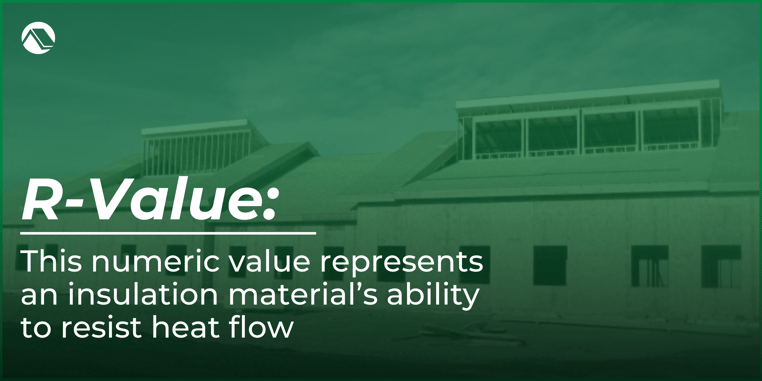
R-value testing, as performed by the Oak Ridge National Laboratory (ORNL), evaluates energy loss in corners, joints, insulation, and areas around windows, as well as various structural components.
The formula to calculate R-value is “R-value = Thickness (in meters) / Thermal Conductivity (in watts per meter per Kelvin).” Here's what each component means:
Local building codes and standards often prescribe minimum R-values for different regions and climates, helping to ensure that structures meet energy efficiency requirements.
The R-value of insulation materials can vary based on factors such as density, air permeability, and moisture content. It's essential to choose insulation materials with appropriate R-values for specific applications to achieve optimal energy efficiency and comfort in buildings.
When designing or renovating a building, understanding R-values and selecting insulation materials with suitable R-values for the intended purpose can contribute to reduced energy consumption and lower heating and cooling costs.
It’s important to note that the 2021 International Code Council (ICC) building codes require higher efficiency, although not all regions and states have adopted these standards yet. For areas that have adopted them, enforcement is going to also take some time.
When designing a building, there are two ways to meet the codes:
Determining a building’s U-factor involves more than just adding up R-values. Often referred to as the "whole wall R-value," the U-factor accounts for how the various materials of the assembly perform when put together, plus the R-value of the film-like layer of air surrounding the structure.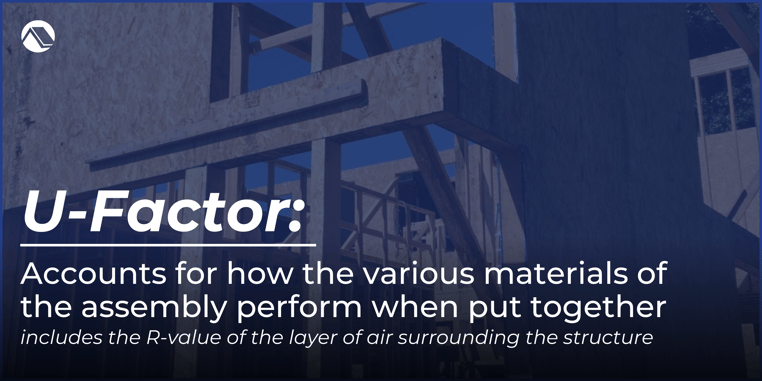
In most cases, U-factors are the preferred method for analyzing how SIPs meet energy codes because they consider all modes of heat transfer, including conduction, convection, and radiation. SIPs are known for their excellent thermal performance due to the insulating foam core, and U-factors capture this performance comprehensively.
Premier’s structural insulated panels are manufactured using expanded polystyrene (EPS) or graphite polystyrene (GPS) foam cores sandwiched between rigid outer panels to create a highly insulated and energy-efficient building material.
Learn how these different materials impact warranted R-values and, in turn, energy efficiency.
One type of Premier’s SIP panels is manufactured with expanded polystyrene (EPS), an insulation material that does not lose its R-value over time. Because these panels’ R-values remain stable throughout their service life, businesses and homeowners benefit from long-term energy savings.
Also due to their enhanced R-value, standard SIPs with EPS insulation cores help create a building envelope that is not only energy-efficient but also offers improved indoor air quality and temperature control, creating a clean, healthy environment, both inside and out.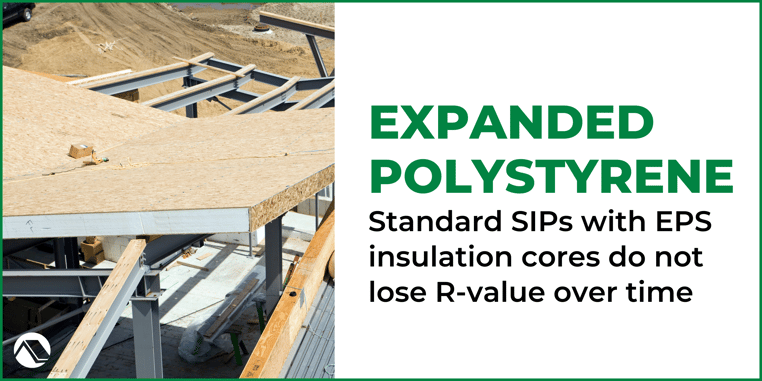
As an efficient, environmentally-friendly product, SIPs can contribute toward LEED® credit requirements, with potential Platinum certification, and also qualify homeowners for significant tax credits.
Premier SIPS MAX are an upgrade to standard EPS core insulation. MAX SIPs are made with graphite polystyrene (GPS) rigid insulation cores, which increase R-values through the graphite’s ability to reflect radiant heat. The result is a cost-effective panel that offers an average of 20% higher R-values than traditional SIPs.
GPS is a new class of insulation made with BASF’s Neopor®, a rigid foam that integrates high-purity graphite into the polymer matrix. The graphite reflects radiant heat energy like a mirror, increasing the material’s resistance to the flow of heat — or R-value..png?width=762&height=381&name=AirtightSIPs_PremierSIPs%20(2).png)
In addition to their 20% warranted higher R-values, Premier SIPS MAX also provide the following benefits:
Premier SIPS MAX building assembly products are truly the epitome of high-performance offsite framing systems, and able to increase energy efficiency without significant cost increases.
“From superior whole wall air tightness to significant reductions in thermal breaks, SIPs are the most energy-efficient structural system available,” said James Hodgson, General Manager for Premier Building Systems. “With the added thermal efficiency of Premier GPS SIPs, we’ve made a high-performance product even better.”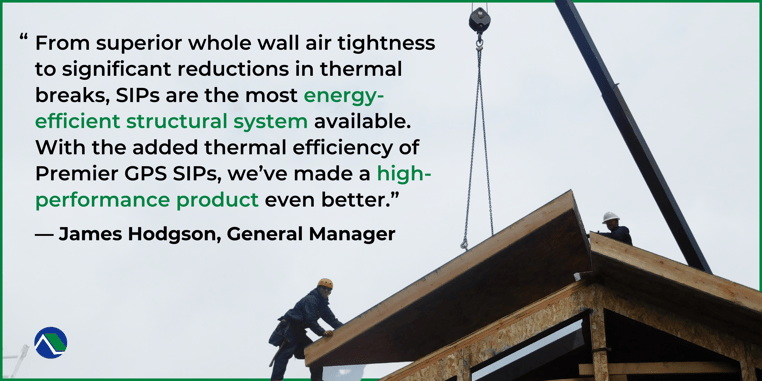
SIPs and stick-framed construction, also known as traditional wood framing, are two different approaches to building construction, each with its own advantages and characteristics when it comes to insulation and R-values.
SIPs tend to provide higher overall insulation performance compared to stick-framed walls because the continuous insulation core in SIP panels reduces thermal bridging.
Additionally, SIPs offer consistent and uniform insulation across the entire panel due to their design, while stick-framed walls may have variations in insulation due to stud spacing and potential installation issues.
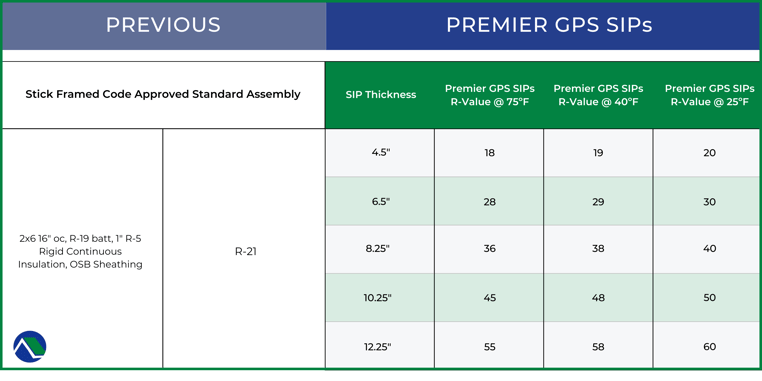
It's important to reiterate that R-values can vary based on the specific materials used. For example, Premier SIPS MAX, made with graphite rigid insulation polystyrene cores, offer 41% higher warranted R-values over stick-framed & batt insulation building envelope assemblies.
Premier Building Systems, North America’s largest manufacturer of SIPs, offers products that provide enhanced energy efficiency through their superior R-values.
As a highly efficient alternative to traditional stick-frame construction, SIPs have consistently outperformed other methods of construction in whole-wall R-value comparisons, providing a whole-wall energy efficiency that is 51% higher than that of traditional two-by-six, R19 construction.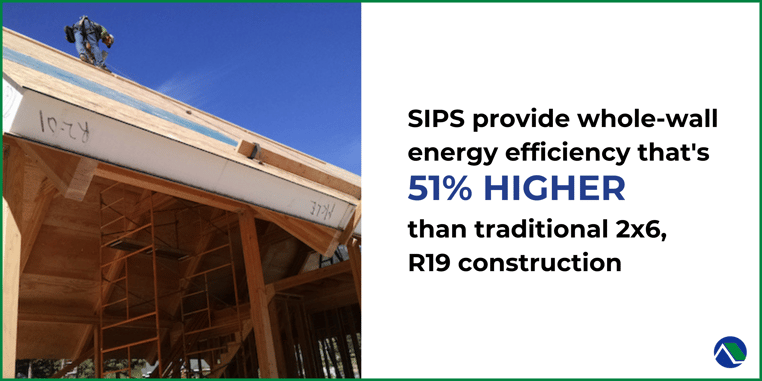
For more information about our game-changing structural insulated panels, connect with a Premier SIPS representative in your area.
Lumber tariffs driving up costs? SIPs cut lumber use by up to 80%, lower labor needs, and deliver stronger, faster, more..
SIPs deliver proven energy savings. Third-party studies show 40–60% lower energy use, smaller HVAC loads, and long-term..
Learn what’s changing—and what’s not—with energy tax credits for SIP projects. Get the latest updates on 25D, 45L, 179D, and..
High-performance buildings start with better systems.
Premier SIPS deliver a building envelope that outperforms traditional framing in efficiency, strength, and long-term durability. If your project demands higher performance and greater predictability, let’s talk.